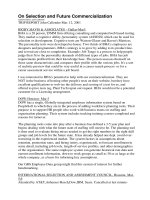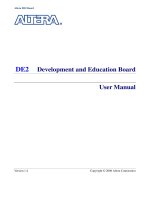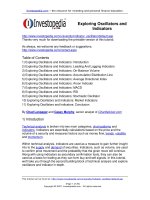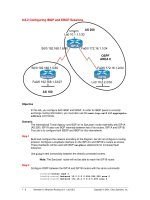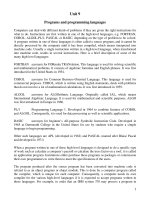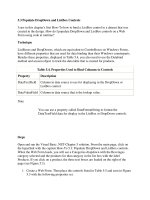Tài liệu Exploring Complementary and Alternative Medicine pdf
Bạn đang xem bản rút gọn của tài liệu. Xem và tải ngay bản đầy đủ của tài liệu tại đây (1.52 MB, 53 trang )
THE RICHARD AND HINDA ROSENTHAL LECTURES
2001
Exploring Complementary
and Alternative Medicine
THE NATIONAL ACADEMIES PRESS
Washington, D.C.
www.nap.edu
THE NATIONAL ACADEMIES PRESS • 500 Fifth Street, N.W. • Washington, DC 20001
NOTICE: The project that is the subject of this report was approved by the Governing Board of the National Research Council, whose members are drawn from
the councils of the National Academy of Sciences, the National Academy of Engineering, and the Institute of Medicine. The members of the committee responsible
for the report were chosen for their special competences and with regard for appropriate balance.
Support for this project was provided by the Richard and Hinda Rosenthal Foundation.
Inernational Standard Book Number 0-309-08503-9
Copies of this report are available from the National Academies Press, 500 Fifth
Street, NW, Lockbox 285, Washington, DC 20055 (800) 624-6242 or (202) 334-3313
(in the Washington metropolitan area); Internet, . Additional
copies of this report are available from the Office of Reports and Communication,
Institute of Medicine, 500 5th St. N.W., Washington, DC 20001. For more information about the Institute of Medicine, visit the IOM home page at: www.iom.edu.
Copyright 2003 by the National Academy of Sciences. All rights reserved.
Printed in the United States of America.
The serpent has been a symbol of long life, healing, and knowledge among almost
all cultures and religions since the beginning of recorded history. The serpent
adopted as a logotype by the Institute of Medicine is a relief carving from ancient
Greece, now held by the Staatliche Museen in Berlin.
“Knowing is not enough; we must apply.
Willing is not enough; we must do.”
—Goethe
Shaping the Future for Health
The National Academy of Sciences is a private, nonprofit, self-perpetuating
society of distinguished scholars engaged in scientific and engineering research,
dedicated to the furtherance of science and technology and to their use for the
general welfare. Upon the authority of the charter granted to it by the Congress in
1863, the Academy has a mandate that requires it to advise the federal government on scientific and technical matters. Dr. Bruce M. Alberts is president of the
National Academy of Sciences.
The National Academy of Engineering was established in 1964, under the charter
of the National Academy of Sciences, as a parallel organization of outstanding
engineers. It is autonomous in its administration and in the selection of its
members, sharing with the National Academy of Sciences the responsibility for
advising the federal government. The National Academy of Engineering also
sponsors engineering programs aimed at meeting national needs, encourages
education and research, and recognizes the superior achievements of engineers.
Dr. Wm. A. Wulf is president of the National Academy of Engineering.
The Institute of Medicine was established in 1970 by the National Academy of
Sciences to secure the services of eminent members of appropriate professions in
the examination of policy matters pertaining to the health of the public. The
Institute acts under the responsibility given to the National Academy of Sciences
by its congressional charter to be an adviser to the federal government and, upon
its own initiative, to identify issues of medical care, research, and education.
Dr. Harvey V. Fineberg is president of the Institute of Medicine.
The National Research Council was organized by the National Academy of
Sciences in 1916 to associate the broad community of science and technology with
the Academy’s purposes of furthering knowledge and advising the federal government. Functioning in accordance with general policies determined by the
Academy, the Council has become the principal operating agency of both the
National Academy of Sciences and the National Academy of Engineering in providing services to the government, the public, and the scientific and engineering
communities. The Council is administered jointly by both Academies and the
Institute of Medicine. Dr. Bruce M. Alberts and Dr. Wm. A. Wulf are chair and
vice chair, respectively, of the National Research Council.
www.national-academies.org
Foreword
In 1988, an exciting and important new program was launched at the
Institute of Medicine. Through the generosity of the Richard and Hinda
Rosenthal Foundation, a lecture series was established to bring to greater
attention some of the critical health policy issues facing our nation today.
Each year a subject of particular relevance is addressed through three lectures presented by experts in the field. The lectures are published at a
later date for national dissemination.
The Rosenthal lectures have attracted an enthusiastic following
among health policy researchers and decision makers, both in Washington, D.C., and across the country. Our speakers are the leading experts on
the subjects under discussion and our audience includes many of the major policymakers charged with making the U.S. health care system more
effective and humane. The lectures and associated remarks have engendered lively and productive dialogue. The Rosenthal lecture included in
this volume explores the world of complementary medicine and its implications for medical research, clinical practice, and policy in the United
States. There is much to learn from the informed and real-world perspectives provided by the contributors to this book.
I would like to give special thanks to Roger Bulger for moderating the
November 2001 lecture. In addition, I would like to express my appreciation to Jennifer Otten, Bronwyn Schrecker, Hallie Wilfert, Jennifer Bitticks,
and Curtis Taylor for ably handling the many details associated with the
lecture programs and the publication. No introduction to this volume
v
vi
FOREWORD
would be complete, however, without a special expression of gratitude to
the late Richard Rosenthal and to Hinda Rosenthal for making this valuable and important education effort possible and whose keen interest in
the themes under discussion further enriches this valuable IOM activity.
Harvey V. Fineberg, M.D., Ph.D.
President
Institute of Medicine
Contents
COMPLEMENTARY AND INTEGRATIVE MEDICAL THERAPIES:
CURRENT STATUS AND FUTURE TRENDS
David Eisenberg, M.D.
1
THE EXTRAORDINARY CASE OF DIETARY SUPPLEMENTS
Catherine Woteki, Ph.D.
25
DISCUSSION
33
BIOSKETCHES
43
vii
Complementary and Integrative
Medical Therapies:
Current Status and Future Trends
❧
David Eisenberg
I. DEFINITIONS AND TERMINOLOGY
“Complementary,” “Alternative,” and
“Integrative” Medical Approaches
Complementary and alternative medical (CAM) therapies encompass
a broad spectrum of practices and beliefs (1). From an historical standpoint, they may be defined “... as practices that are not accepted as correct, proper, or appropriate or are not in conformity with the beliefs or
standards of the dominant group of medical practitioners in a society” (2).
From a functional standpoint, complementary (a.k.a.”alternative”) therapies may be defined as interventions neither taught widely in medical
schools nor generally available in hospitals (3). Ernst et al. contend that
“complementary” medical techniques “[complement] mainstream medicine by contributing to a common whole, by satisfying a demand not met by
orthodoxy or by diversifying the conceptual frameworks of medicine” (4).
The terminology currently in use to describe these practices remains controversial. Many commonly used labels (e.g., “alternative,” “unconventional,” “unproven”) are judgmental and may inhibit the collaborative
inquiry and discourse necessary to distinguish useful from useless techniques (5). Complementary and alternative medicine (CAM) is the language currently used by the National Institute of Health (NIH) and U.S.
federal agencies to describe this field of inquiry. The NIH National Center
for Complementary and Alternative Medicine (NCCAM) defines CAM as
“healthcare practices outside the realm of conventional medicine, which
1
2
COMPLEMENTARY AND INTEGRATIVE MEDICAL THERAPIES
are yet to be validated using scientific methods.” Two recent articles by
Kaptchuk et al., explore the taxonomy of CAM therapies in the context of
medical pluralism (6;7).
Integrative medicine refers to ongoing efforts to combine the best of
conventional and evidence-based complementary therapies while emphasizing the primacy of the patient-provider relationship and the importance of patient participation in health promotion, disease prevention, and
medical management. “It (integrative medicine) views patients as whole
people with minds and spirits as well as bodies and includes these dimensions into diagnosis and treatment” (8). In the January 2001 British Medical
Journal edition devoted entirely to integrated medicine, the Journal’s editor, Richard Smith, wrote: “It mightn’t be too pretentious (although it
might) to say that such a growth (of integrative medicine) might restore
the soul to medicine—the soul being that part of us that is the most important but the least easy to delineate” (9). A variety of articles and editorials
have wrestled with the challenges of properly labeling and describing this
field of inquiry (8;10-16).
Dietary Supplements
The Dietary Supplement Health and Education Act (DSHEA) defines
dietary supplements as products (other than tobacco) intended to supplement the diet that bear or contain one or more of the following dietary
ingredients: a vitamin, mineral, amino acid, herb or other botanical; or a
dietary substance for use to supplement the diet by increasing the total
dietary intake; or a concentrate, metabolite, constituent, extract, or combination of any ingredient described above; and intended for ingestion in
the form of a capsule, powder, soft gel, or gelcap, and not represented as
a conventional food or as a sole item of a meal or the diet. The DSHEA
legislation stipulates that botanicals and other dietary supplements are
not “drugs” and, as such, are not held to the same regulatory requirements as drugs (i.e., prerequisite evidence of both safety and efficacy).
Manufacturers of dietary supplements are not allowed to make “disease
claims” but are permitted to make “structure/function” claims. This has
resulted in a range of interpretations and has complicated both clinical
decision making and efforts to perform scientific research involving botanicals (17;18).
3
DAVID EISENBERG
II. EPIDEMIOLOGY
A. Prevalence, Costs, and Patterns of Use of CAM Therapies in the
United States
Findings from a 1997 follow-up national survey of complementary
and alternative medicine (CAM) prevalence, costs, and patterns of
use (19) include the following:
Between 1990 and 1997:
• The prevalence of CAM use increased by 25 percent from 33.8 percent in 1990 to 42.1 percent in 1997.
• The prevalence of herbal remedy use increased by 380 percent.
• The prevalence of high-dose vitamin use increased by 130 percent.
• The total number of visits to CAM providers increased by 47 percent from 427 million in 1990 to 629 million in 1997.
• The total visits to CAM providers (629 million) exceeded total visits to all primary care physicians (386 million) in 1997.
• In 1997, adults made an estimated 33 million office visits to professionals for advice regarding the use of herbs and high-dose vitamins.
• Estimated expenditures for CAM professional services increased
by 45 percent exclusive of inflation and in 1997 were estimated at $21.2
billion dollars.
• Out-of-pocket expenditures for herbal products and high-dose vitamins in 1997 were estimated at $8 billion.
• Out-of-pocket expenditures for CAM professional services in 1997
were estimated at $12.2 billion. This exceeded the out-of-pocket expenditures for all U.S. hospitalizations.
• Total out-of-pocket expenditures relating to CAM therapies were
conservatively estimated at $27.0 billion. This is comparable to the projected out-of-pocket expenditures for all U.S. physician services.
• An estimated 15 million adults in 1997 took prescription medications concurrently with herbal remedies and/or high-dose vitamins.
These individuals are therefore at risk for potential adverse drug-herb or
drug-supplement interactions.
• Current use of CAM services is likely to under-represent utilization patterns if insurance coverage for CAM therapies increases in the
future.
• Despite the dramatic increases in the use and expenditures associated with CAM services, the extent to which patients disclose their use of
CAM therapies to their physicians remains low. Fewer than 40 percent of
CAM therapies used were disclosed to a physician in both 1990 and 1997.
4
COMPLEMENTARY AND INTEGRATIVE MEDICAL THERAPIES
The authors concluded that CAM use and expenditures increased substantially between 1990 and 1997, attributable primarily to an increase in
the proportion of the population seeking CAM therapies, rather than increased visits per patient.
Other nationally representative surveys of CAM prevalence and patterns of use have provided additional useful information. These include a
study by Astin (20) which concluded that “…the majority of alternative
medicine users appear to be doing so not so much as a result of being
dissatisfied with conventional medicine, but largely because they find
their health care alternatives to be more congruent with their own values,
beliefs and philosophical orientation towards health and life.” Druss and
Rosenheck’s national survey (21) found that practitioner-based CAM
therapies appear to serve more as a complement than an alternative to
conventional medicine; and, individuals in the top quartile of numbers of
physician visits were more than twice as likely as those in the bottom
quarter to have used CAM therapies during the prior year. Two recent
analyses of national survey data provide additional information regarding CAM patterns of use in adults over age 65 (22) and adults with anxiety
or depression (23).
A recent publication by Kessler et al. examines the long-term trends
in the use of CAM in the United States (24). It found that 68 percent of
adults had used at least one CAM therapy in their lifetime; and lifetime
use steadily increased with age across age cohorts: approximately three
in 10 respondents in the pre-baby boom cohort, five of 10 in the baby
boom cohort, and seven to 10 in the post baby boom cohort reported using some type of CAM therapy by age 33. Moreover, a wide range of
individual CAM therapies increased in use over time, and the growth was
similar across all major sociodemographic sectors. The authors concluded,
“Use of CAM therapies by a large proportion of the study sample is the
result of a secular trend that began at least a half century ago. This trend
suggests a continuing demand for CAM therapies that will offset health
care delivery for the foreseeable future.”
A recent publication by Eisenberg et al. examined perceptions about
CAM therapies relative to conventional therapies among adults who used
both. The authors found that the majority of CAM therapy users: (1) perceived the combination of CAM and conventional care to be superior to
either alone (79 percent); (2) typically saw a medical doctor before or concurrent with their visits to a CAM provider (70 percent); (3) had a similar
level of perceived confidence in both their CAM provider and MD; and
(4) they did not disclose their CAM therapy to their medical doctor (63-72
percent). Principal reasons for nondisclosure were: “It wasn’t important
for the doctor to know” (61 percent); “The doctor never asked” (60 percent); “It was none of the doctor’s business” (31 percent); and “The doctor
DAVID EISENBERG
5
would not understand” (20 percent). Fewer respondents (14 percent)
thought their doctor would disapprove of or discourage CAM use. The
authors concluded that, “Adults who use both expect to value both and
that to be less concerned about their doctor’s disapproval than about their
doctor’s inability to understand or incorporate CAM therapy use within
the context of their medical management.” (25)
The above-mentioned surveys are all based on nationally representative random samples of adult Americans. In addition, there have been a
number of convenience samples investigating CAM therapy use among
individuals with a particular condition or disease. Examples include surveys involving CAM therapy use among individuals with: cancer (26-35);
rheumatologic disorders (36-38); self-reported disability (39); HIV (40);
inflammatory bowel disease (41); and rhinosinusitis (42); as well as surgical patients (43); and patients in an emergency department (44).
National surveys performed outside the United States suggest that
CAM is popular throughout the industrialized world (45). The percentage of the population who used CAM therapies during the prior 12
months has been estimated to be 10 percent in Denmark (1987) (46), 33
percent in Finland (1982) (47), and 49 percent in Australia (1993) (48). Public opinion polls and consumers’ association surveys suggest high prevalence rates throughout Europe and the United Kingdom (49-52). The percentage of the Canadian population who saw a CAM therapy practitioner
during the previous 12 months has been estimated at 15 percent (1995)
(53). The wide range of utilization rates can be explained, in part, by the
disparity in definitions of CAM therapy and the selection of therapies
assessed.
B. Prevalence and Patterns of Use of Herbal Products, Vitamins, and
Non-Herbal Dietary Supplements in the United States
A recent JAMA publication by Kaufman et al. (54) describes patterns
of medication use (for both prescription and non-prescription drugs) by
the ambulatory adult population of the United States. Among their findings were the observations that: (1) 40 percent of the population routinely
used one or more vitamin or mineral supplements; (2) herbals and supplements were taken by 14 percent of the population over the prior week; (3)
among prescription drug users, 16 percent also took an herbal or supplement.
Attitudes Toward Dietary Supplement Regulation
A recent study by Blendon et al. (55), involving Americans’ views on
regulating dietary supplements, suggests that:
6
COMPLEMENTARY AND INTEGRATIVE MEDICAL THERAPIES
• Forty-four percent of users believe MDs know “little” or “not much
at all” about these products.
• Seventy-two percent would continue use even if a government scientific study was negative.
• Eighty-one percent would require evidence of efficacy, safety, and
FDA approval prior to allowing for the sale of the product.
TABLE 1 Ten Most Commonly Used Vitamins/Minerals and Herbals/
Supplements
Ten Most Commonly Used
Vitamins/Minerals*
Ten Most Commonly Used
Herbals/Supplements*
Vitamin/Mineral
% Use
Herbal/Supplement
% Use
Multivitamin
Vitamin E
Vitamin C
Calcium
Magnesium
Zinc
Folic Acid
Vitamin B12
Vitamin D
Vitamin A
26
10
9
9
3
2
2
2
2
2
Ginseng
Gingko
Garlic
Glucosamine
St. John’s Wort
Echinacea
Lecithin
Chondroitin
Creatine
Saw Palmetto
3.3
2.2
1.9
1.9
1.3
1.3
1.1
1.0
0.9
0.9
Any Vitamin/Mineral
40
Any Use
14
*Kaufman, et al. (54).
In light of these findings, the authors conclude that there is broad
public support to increase governmental regulation to ensure that advertising claims about health benefits of dietary supplements are true.
III. EDUCATIONAL PROGRAMS
A survey of courses involving CAM at U.S. medical schools was published in the 1998 JAMA theme issue devoted to medical education (56).
This article, by M. Wetzel et al., included the following results: 64 percent
of the U.S. medical schools reported offering courses on CAM. Of the 123
courses reported, 68 percent were stand-alone electives and 31 percent
were part of required courses. Common topics included chiropractic, acupuncture, homeopathy, herbal therapies, and mind-body techniques. The
American Association of Medical Colleges has established a Special Inter-
7
DAVID EISENBERG
TABLE 2
Top Selling U.S. Herbal Supplements
2001 vs. 2000
U.S. Vitamins and Mineral Sales
Retail
Sales
$ Millions
$Millions
Multivitamins
Calcium
Vitamin C
Vitamin B-complex
Vitamin B
Iron
Vitamins A & D
Zinc
Potassium
839
340
230
90
82
57
34
28
14
Gingko
Ginseng
Garlic
Echinacea
St. John’s Wort
Saw Palmetto
Soy
Valerian
Kava Kava
Milk Thistle
Green Tea
Yohimbe
Total Herbs
(Drug Store News, May 2000)
% Change
From
2000 to 2001
99
63
61
58
56
44
41
17
15
9
3
2
–32
–25
–20
–20
–45
–2.5
+116
+71
–16
+15
+39
+13
591
-15%
(Herbal Gram; 51, 2001)
TABLE 3
Non-Herbal Dietary Supplement Sales
Top Herbs, U.S. vs. Europe
United States†
$Millions
Glucosamine / chondroitin
CoQ-10
Melatonin
Amino acids
Fish oil / omega fatty acid
DHEA
Acidophilus
Lecithin
Gelatin
Glucose
Shark cartilage
288
41
31
21
14
11
11
10
8
7
6
1
2
3
4
5
6
7
8
9
10
Gingko Biloba
St. John’s Wort
Ginseng
Garlic
Echinacea
Saw Palmetto
Kava Kava
Soy
Valerian
Evening Primrose
† Drug
(Drug Store News, May 2000)
Europe‡
Gingko Biloba
St. John’s Wort
Horse Chestnut
Yeast
Hawthorn
Myrtle
Saw Palmetto
Stinging Nettle
Ivy
Mistletoe
Store News, May 2000
Commission E, 1998
‡ German
8
COMPLEMENTARY AND INTEGRATIVE MEDICAL THERAPIES
est Group devoted to CAM, and this topic continues to be discussed at the
AAMC’s annual meetings and by the AAMC Council of Deans.
An article by Caspi et al. questions “whether a true integration of conventional and unconventional therapies is even possible” and addresses
educational options in this regard (57).
In recent years, the NIH NCCAM has awarded multiple educational
training grants to a growing number of medical schools, universities, and
CAM educational institutions. These grants include the following: Fellowship Training Program Grants; Faculty Development Awards; Curriculum Development Grants; and support for CAM-related educational
conferences and meetings. Ten medical schools have received curriculum
development grants (R-25) and will be meeting to discuss reproducible
models of CAM-related curriculum reform. (See NCCAM website:
www.nccam.nih.gov for additional information; see also the Macy Foundation proceedings relating to CAM education [58].) Currently, there is
no standardized curriculum involving CAM medicine educational objectives at the undergraduate, post-graduate, or continuing medical educational levels.
IV.
RESEARCH: BEST EVIDENCE
In 1992, the NIH established the Office of Alternative Medicine. In
November of 1998, Congress established the National Center for Complementary and Alternative Medicine (NCCAM). Its mission is: “To prevent
and alleviate human suffering through research on the safety and effectiveness of CAM modalities and through research, training, and information dissemination for healthcare providers and consumers.” Currently,
the NIH supports more than 200 studies involving complementary and
alternative medicine therapies. (Additional information on NCCAM can
be found at: http:/
/www.nccam.nih.gov)
The NIH has also established the Office of Dietary Supplements
(ODS). The scientific goals of the ODS include:
Goal 1: Evaluate the role of dietary supplements in the prevention
of disease and reduction of risk factors associated with disease.
Goal 2: Evaluate the role of dietary supplements in physical and
mental health and in performance.
Goal 3: Explore the biochemical and cellular effects of dietary
supplements on biological systems and their physiological impact across
the life cycle.
Goal 4: Improve scientific methodology as related to the study of
dietary supplements.
DAVID EISENBERG
9
Goal 5: Inform and educate scientists, healthcare providers, and the
public about the benefits and risks of dietary supplements.
(Additional information on the ODS can be found at .
gov/ods/about/about.html)
Prior to 1990, relatively little was known about the relative safety,
efficacy, cost-effectiveness, and mechanism of action of individual CAM
therapies. Increasingly, however, the peer-reviewed medical literature has
included consensus conferences, randomized controlled trials, systematic
reviews, and meta-analyses involving CAM therapies. Noteworthy examples of recently published original trials and reviews include:
Selected Consensus Reports, Clinical Trials, and Reviews Suggesting That
CAM Therapies May Be Effective and/or Warrant Further Clinical
Investigation
1)
2)
3)
4)
5)
6)
7)
8)
9)
10)
11)
12)
13)
14)
15)
16)
17)
18)
19)
20)
21)
22)
23)
24)
25)
Chiropractic for Acute Low Back Pain (59;60)
Mind/Body Techniques for Pain, Insomnia (61)
Lifestyle Changes for Coronary Heat Disease (62;63)
Acupuncture for Nausea and Dental Pain (64)
Psychosocial Support Groups for Cancer (65)
Homeopathy as Distinct from Placebo (66)
St. John’s Wort for the Treatment of Depression (67)
St. John’s Wort vs. Imipramine vs. Placebo (68)
Gingko for the Treatment of Alzheimer’s Type Dementia (69;70)
Chinese Herbs for the Treatment of Irritable Bowel Syndrome (71)
Saw Palmetto for the Treatment of Benign Prostatic Hyperplasia (72)
Garlic for Hypercholesterolemia (73-75)
Glucosamine and Chondroitin for Osteoarthritis (76;77)
Kava Kava for Anxiety (78)
Homeopathy for Vertigo (79)
Homeopathy for Allergic Rhinitis (80)
Osteopathic Manipulation for Low Back Pain (81)
Moxibustion for Breech Presentation (82)
Acupuncture for Recurrent Headaches (83)
Acupuncture for Post-operative Nausea (84)
Acupuncture for Fibromyalgia (85)
Distant Healing (86)
Intercessory Prayer (87)
Massage for Low-Back Pain (88)
Agnus Castus Extract for Premenstrual Syndrome (89)
10
COMPLEMENTARY AND INTEGRATIVE MEDICAL THERAPIES
26) Tai Chi for Balance Disorders (90)
27) Selected Herbal Therapies (e.g., Gingko, St. John’s Wort and Saw
Palmetto) (91)
28) Adjunctive Non-pharmacological Analgesia for Invasive Medical
Procedures (92)
Selected Clinical Trials Suggesting That CAM Therapies May Lack Efficacy
1) Acupuncture for Peripheral Neuropathy (93)
2) Hydroxycitric Acid for Obesity (94)
3) Chiropractic vs. Physical Therapy vs. Education for Low Back
Pain (95)
4) Acupuncture for Tinnitus (96)
5) St. John’s Wort for Major Depression (97)
6) Homeopathy for Warts on the Hands (98)
7) Homeopathy for Muscle Soreness (99)
8) Herbal Remedies for Asthma (100)
9) Hair Analysis of Trace Minerals (101)
10) Chiropractic for Infantile Colic (102)
11) Group Psychosocial Support for Metastatic Breast Cancer
(103;104)
Selected Articles Describing Significant Drug-Herb Interactions and/or
Toxicity
Over the past two years, the medical literature has included several
reports of clinically significant adverse events caused by the direct or indirect toxicity of herbal products. Notable examples include:
1) Case Studies Involving the Most Commonly Used Medicinal Plants (105);
2) Adverse Reactions Between St. John’s Wort and Prescription Drugs
(106);
3) Open-label Study Showing St. John’s Wort Decreases Indinavir Concentrations (107);
4) Association of a Chinese Herb (Aristolochia fangchi) with Renal Failure
and Urothelial Carcinoma (108);
5) Letter to Lancet Editor regarding St. John’s Wort Induced Heart Transplant Rejections (109); and
6) Summary of Ephedra’s Toxicity (110).
DAVID EISENBERG
11
Selected Articles Relating to the Mechanisms of CAM Interventions and
Placebo-Related Phenomena
Investigating the mechanisms of actions of CAM therapies is now a
high priority for the NIH and NCCAM. Notable examples of recent publications in this area include:
1) Expectation and Dopamine Release: Mechanism of the Placebo Effect in
Parkinson’s Disease (111);
2) Changes in Brain Function of Depressed Subjects During Treatment with
Placebo (112);
3) Functional MRI Studies of Acupuncture in Normal Subjects—Localization of Processing (113);
4) Functional MRI Studies of Acupuncture in Normal Subjects (114);
5) Is the Placebo Powerless? (115);
6) Response Expectancies in Placebo Analgesia and Their Clinical Relevance
(116); and
7) MRI Imaging of Placebo (117).
V. HOW CAM/INTEGRATIVE MEDICINE RESEARCH HAS
FOLLOWED AN UNUSUAL TRAJECTORY
Conventional biomedical research typically follows a trajectory that
begins with basic science and animal research, followed by Phase I, II, and
III clinical (human) trials. If effective, new therapies are then evaluated
for their cost-effectiveness and appropriate health care policy is ultimately
developed.
This has not been the case, however, for much of complementary and
integrative medicine therapies, the majority of which have not yet been
formally evaluated in terms of their mechanism of action (i.e., basic science research) and clinical or cost-effectiveness (health services research).
Ernst has documented the relative absence of cost-effectiveness research
involving CAM Integrative Medicine interventions (118). Both basic science and health services research are emerging as high priorities for both
governmental (e.g., NIH) and private sector sponsored research in this
area (e.g., research sponsored by pharmaceutical companies, insurance
carriers, Fortune 500 corporations).
In a recent article, Vandenbroucke and de Craen argue that CAM research provides a “mirror image” for scientific reasoning in conventional
medicine. More specifically, they provide several examples in which physicians discard a theory because of new facts, or, alternatively, cling to a
theory despite the facts (119).
12
COMPLEMENTARY AND INTEGRATIVE MEDICAL THERAPIES
CONVENTIONAL /ORTHODOX
COMPLEMENTARY/INTEGRATIVE
Basic Science
Epidemiology/Popular Demand
Cellular, in-vitro
Political Support
Animal models
Clinical Trials, Phase II, III
Clinical Trials, Phase I, II, III
Cost-Effectiveness/ [Health Service]
Cost-Effectiveness/Health Science
Basic Science/ [Animal/in-vitro]
Scientific [Acceptance]
Health Policy/Reimbursement/Politics
Health Policy/Reimbursement/Politics
Change Healthcare Delivery
Change Healthcare Delivery
FIGURE 1
VI. CREDENTIALING AND MALPRACTICE
LIABILITY CONCERNS
The oversight of educational requirements, credentialing, malpractice insurance, and scope of practice vary from state to state (120;121) (122).
A tabular summary of state licensing patterns for chiropractic, acupuncture, massage therapy, homeopathy, and naturopathy is available elsewhere (120;121).
David Studdert, J.D., Ph.D., et al. examined malpractice insurance
claims data from both the conventional (MD) and CAM (i.e., chiropractic,
acupuncture, massage) communities (123). Their findings, published in
JAMA included the observation that claims against licensed CAM practitioners occurred less frequently and typically involved injury that was
less severe than claims against physicians during the same period. This
article also described specific situations in which referral by a medical
doctor to a licensed CAM practitioner will or will not likely be construed
as negligent. The texts by Michael Cohen (124;125) also highlight many
DAVID EISENBERG
13
CAM related legal concerns. An article by Cohen and Ernst addresses
issues of informed consent involving CAM (126). The Annals of Internal
Medicine special series on CAM has scheduled the publication of individual papers on CAM-related malpractice, credentialing and ethics in
the spring of 2002. In addition, the Federation of State Medical Boards is
scheduled to vote on model guidelines for the use of CAM therapies in
medical practice later this year (2002).
VII. EMERGING MODELS FOR THE CLINICAL DELIVERY OF
COMPLEMENTARY AND INTEGRATIVE MEDICAL THERAPIES
Increasingly, hospitals, managed care organizations, health insurers
and large, self-insured corporations are developing models whereby
CAM/integrative therapies are made available to members, subscribers,
and employees. The spectrum of existing models, all relatively new, is
broad and includes:
• The establishment of networks of “credentialed” complementary
and alternative therapy practitioners.
• Reduced “fee-for-service” models whereby members/subscribers/
employees receive a discount on routine CAM services provided by “credentialed” networks of identified practitioners in a given geographic area.
(Note: This model does not typically include reimbursement for or liability assurance regarding the delivery of CAM services.)
• Covered benefits, which include a predetermined maximum of
complementary and alternative therapy services for selected medical conditions (usually with a required referral from an MD).
• Covered CAM benefits without a required referral from an MD.
• “Integrated” medical services which typically include both conventional and complementary/alternative services, usually in an outpatient
(ambulatory) setting. Reimbursement options vary as do referral requirements.
• “Integrated” consultation services, i.e., the provision of complementary and alternative therapies for inpatients in hospitals.
• The incorporation of complementary and alternative (a.k.a. “integrative”) services as part of an individual medical practice, a group medical practice, a managed care organization, a PPO, an insurance product, a
community hospital, or university-affiliated teaching hospital.
• Specialized integrative care teams consisting of conventional and
complementary care providers working within a medical institution or
group practice. Notable examples include integrative care teams at Beth
Israel Hospital (NY), University of Maryland, Stanford University, Cedars-Sinai, and Memorial Sloan Kettering hospitals.
14
COMPLEMENTARY AND INTEGRATIVE MEDICAL THERAPIES
Integrative Medicine Stakeholders
Government
Managed
Private Sector
(NIH, CDC,
Care, Insurers
(Pharmaceuticals,
AHRQ, DOD)
Fortune 500
Employers, CAM
Universities
Networks)
Medical Schools
Hospitals
Politicians &
Regulators
Integrative
Medicine Centers
(Congress,
Federation of
Philanthropy
Consumers
State Med.
Boards, FDA)
FIGURE 2
Unlike hospitalizations and physician services, complementary and
alternative therapies are only infrequently included in insurance benefits.
With the exception of chiropractic, CAM therapies are typically not covered by third-party reimbursement. The percentage of CAM users who
paid entirely out-of-pocket for these services did not change significantly
between 1990 (64 percent) and 1997 (58.3 percent) (19). Even when alternative therapies are covered, they tend to have high deductibles and copayments and tend to be subject to stringent limits on the number of visits
or total dollar coverage. Because the demand for health care (and presumably alternative therapies) is sensitive to how much patients must pay
out-of-pocket, current use is likely to under represent utilization patterns
if (and when) insurance coverage for alternative therapies increases in the
future (19). Trends involving insurance coverage for CAM therapies have
recently been reviewed by Pelletier et al. (127;128). A survey by John
Weeks of 27 hospital-sponsored integrative medicine clinics provides descriptive information on services, practitioners, provider mixes, and profitability issues (129).
While models of “integrative care” have recently begun to develop
DAVID EISENBERG
15
nationwide, a variety of barriers to their success have become apparent.
Many of these barriers were highlighted in a recent NIH request for proposals and include: 1) the need for more research; 2) the ability to translate research findings into clinical practice; 3) fiscal constraints and the
absence of a financially sustainable model; 4) ignorance about CAM therapies on the part of referring physicians; 5) provider competition; 6) liability issues; 7) cultural bias and prejudice; and 8) the lack of standards pertaining to credentialing, patient triage, and third-party reimbursement. In
October 2001, the NIH NCCAM issued eight awards (four RO1s and four
R21s) to a spectrum of institutions and investigators to develop innovative models of integrative care.
VIII. CHALLENGES AND OPPORTUNITIES
FOR STAKEHOLDERS
Further development of CAM/Integrative Medicine research will
require:
• Additional resources and an expanded commitment from both the
public and private sectors to promote additional:
— Clinical research;
— Health services research; and
— Basic science research.
It should be emphasized that all three are essential; moreover, basic science
and health services research need to be prioritized at this time.
• Recruitment of additional research leadership across disciplines
and constituencies (e.g., more basic scientists, clinical investigators, economists, toxicologists, etc.).
• Improved quality assurance of dietary supplements. Can botanicals be standardized for research purposes? Can the FDA, NIH, and Congress revisit current regulatory statutes in order to promote reproducible
scientific inquiry as well as consumer safety?
• A critical mass of university-affiliated CAM/Integrative Medicine
programs with sufficient resources to pursue:
— Research (clinical, basic, health services)
— Educational reform and training
— Clinical delivery of CAM/Integrative Medical services at university-affiliated hospitals
16
COMPLEMENTARY AND INTEGRATIVE MEDICAL THERAPIES
Note: The Consortium of Academic Health Centers for Integrative
Medicine is currently being developed. This consortium currently includes medical school faculty from the Universities of Maryland, Arizona,
Michigan, Minnesota, Massachusetts, Duke, Columbia, Albert Einstein,
Thomas Jefferson, Georgetown, UCSF, and Harvard. The consortium is
developing an agenda which relates to CAM/Integrative Medicine education, research, and clinical care.
• A commitment to primarily pursue inter-disciplinary, inter-institutional, and, where appropriate, international collaboration wherever
possible.
Note: Harvard Medical School and the UCSF School of Medicine have
jointly developed an Annual International Scientific Conference on CAM/
Integrative Medicine Research. This meeting is sponsored, in part, by a
grant from the NIH NCCAM. (The next research conference is scheduled
for April 12-14, 2002 in Boston. For information, contact 781-245-3010.)
The successful delivery of CAM/Integrative Medical services will
require:
• More consistent standards for credentialing of CAM providers.
• More consistent tracking of clinical and financial outcomes.
• The establishment of appropriate guidelines regarding the use (or
avoidance) of herbs, vitamins, and supplements for outpatients and inpatients.
• Demonstration projects that provide evidence of financial and clinical offsets.
• Demonstration projects that provide evidence of financial
sustainability.
• Demonstration projects with revenue streams that include self-pay,
third-party reimbursement, philanthropy, and income from sponsored research.
• Demonstration projects that are functionally integrated into existing medical delivery models (e.g., hospitals, clinics, group practices,
MCOs, etc.).
• Models that include access for CAM services for those with less
expendable income and/or lack of medical insurance.
• Medical-legal guidelines for conventional and CAM practitioners,
institutions and third party payers so as to minimize liability exposure.
• Partnerships and incentives involving government, the academic
community, and the private sector.
